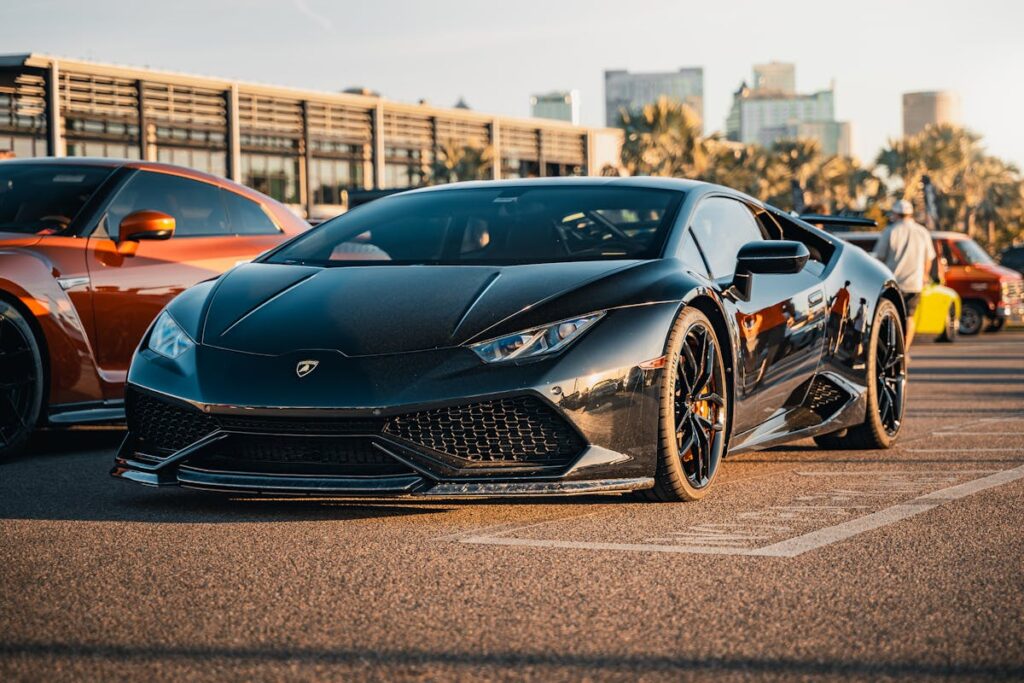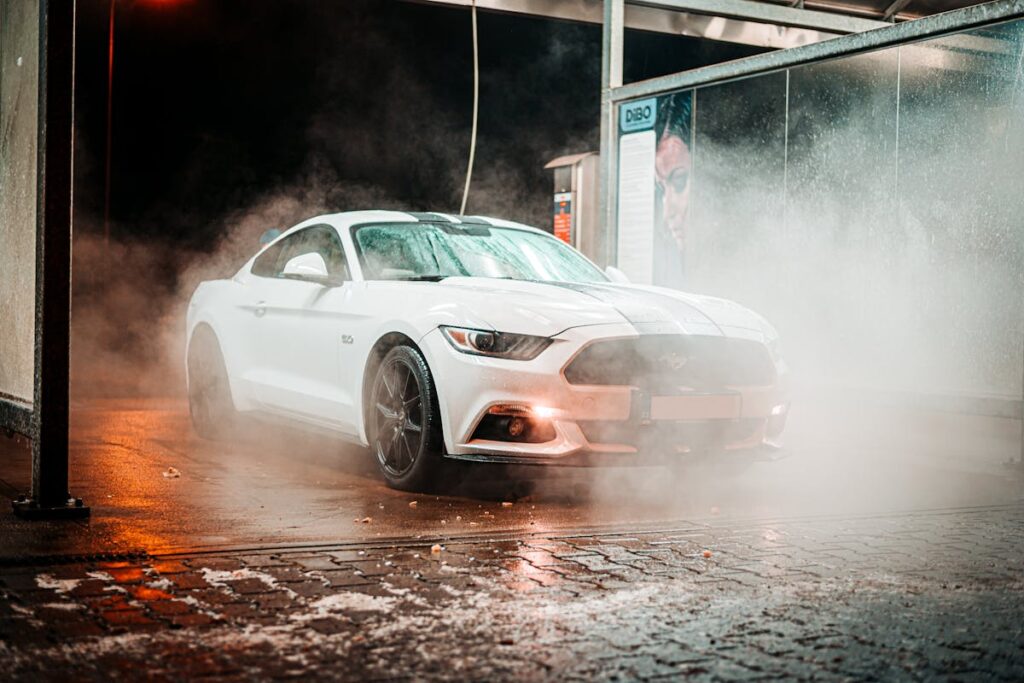The allure of the silver screen often extends beyond compelling narratives and charismatic characters, finding a substantial foothold in the domain of automotive design. Iconic film automobiles such as the Aston Martin DB5 from James Bond, the DeLorean from ‘Back to the Future’, and the 1968 Ford Mustang GT from ‘Bullitt’, have transcended their function as mere props, morphing into cultural icons that have considerably influenced real-world automotive trends. As we navigate the intersection of cinematic creativity and automotive innovation, we unravel the enduring legacy of these vehicles and their profound impact on both pop culture and car enthusiasts.
Aston Martin DB5: The Bond Legacy
As if it were destined for stardom, the Aston Martin DB5 first graced the silver screen in the 1964 James Bond film, “Goldfinger.” This iconic vehicle, with its sleek design and advanced features, quickly became synonymous with the suave, sophisticated image of the British secret agent. From its inception, the DB5 resonated with audiences, fostering a cinematic heritage that endures to this day. Not only was the car’s aesthetic appeal undeniable, but its array of Bond gadgets, including concealed weapons and defensive mechanisms, captivated audiences worldwide. These features transformed the DB5 from mere transportation into a character in its own right. The Aston Martin DB5’s indelible influence on pop culture evidences the powerful intersection of technology, design, and cinematic storytelling.
The DeLorean: A Time-Travelling Icon
Although seemingly unremarkable at first glance, the DeLorean DMC-12 became a cinematic sensation in the “Back to the Future” trilogy. Its futuristic design, complete with gull-wing doors and a stainless-steel body, was a perfect match for the film’s time travel theme. The DeLorean’s role wasn’t just to look the part; it was integral to the narrative, effectively becoming a character itself. Its transformation into a time machine was a demonstration of the ingenuity of the filmmakers and gave the DeLorean an iconic status. Inextricably linked with the concept of time travel, the DeLorean DMC-12 captured the imagination of audiences worldwide, marking it as one of the most memorable vehicles in cinematic history.
1968 Ford Mustang GT: Bullitt’s Speedstar
Shifting gears from the domain of science fiction to the gritty streets of 1960s San Francisco, we encounter another vehicle that has carved its name indelibly into the annals of film history: the 8 Ford Mustang GT from “Bullitt”. Embodying the Mustang’s legacy of raw power and distinct style, this iconic vehicle is pivotal to Bullitt’s chase, a high-octane sequence that forever changed cinema’s perception of car chases. With its roaring engine and muscular build, the Mustang GT became a symbol of American grit and rebellion, echoing the film’s protagonist. The symbiosis of man and machine in “Bullitt” not only defined the character’s persona but also cemented the Mustang GT’s status as an enduring cultural icon of speed and freedom on the silver screen.
Ecto-1: Ghostbusting in Style
The Ecto-1, an unforgettable movie icon, is renowned for its appearances in the Ghostbusters franchise. To fully appreciate its impact, we need to scrutinize its unique design, the specifications that made it a functional ghostbusting vehicle, and the lasting legacy it left on pop culture. This analysis will highlight the Ecto-1’s significance, not just as a movie prop, but as a character in its own right.
Ecto-1’s Memorable Appearances
Emerging from the cinematic universe of Ghostbusters, Ecto-1 has carved its niche as one of the most iconic cars in movie history. The Ecto-1 design, with its distinctive sirens, logos, and equipment, is instantly recognizable, contributing to its significant cultural impact. The vehicle’s memorable appearances in scenes such as the dramatic New York City chases and the climactic showdown at the haunted hotel have made it an integral part of the Ghostbusters narrative. The Ecto-1’s legacy extends beyond the films, infiltrating the domain of merchandise, with numerous models, toys, and even video games celebrating its unique design. This widespread recognition attests to the power of the Ecto-1, not just as a cinematic vehicle, but as a symbol of adventurous spirit and teamwork.
Design and Specifications
Inherent in the identity of Ecto-1 is a creative blend of functionality and aesthetics, making it a standout representation of movie cars. The car aesthetics are visually striking, with its sleek, white body and bold red accents. This symbol of automotive engineering, originally a 1959 Cadillac Miller-Meteor, was transformed into an iconic ghostbusting machine.
Features of Ecto-1 include:
- A distinctive siren sound, unique to the vehicle
- A roof-mounted ghost containment unit
- Customized logo and signage
- High-powered searchlight
- An array of scientific equipment for detecting and capturing ghosts
These design elements, combined with a solid engine performance and spacious interior reflect an innovative approach to car design in movies. Ecto-1 is an embodiment of the blend of creativity and technicality in automotive design.
Legacy and Popularity
Ecto-1, with its unforgettable design and functionality, has left an indelible mark on popular culture. Its unique appearance, coupled with its role in the classic Ghostbusters franchise, has considerably contributed to its enduring legacy. The car’s cultural impact is widespread, transcending the domain of film and permeating various sectors of society, from toy manufacturing to Halloween costumes. Not only has Ecto-1 become a symbol of nostalgia, but its automotive influence has also paved the way for the creation of other memorable movie cars, inspiring designers and filmmakers alike. This goes to show that Ecto-1’s popularity is not solely attributable to the movie it starred in, but also due to the distinctive mark it has made on the automotive and entertainment industries.

The Batmobile: Dark Knight’s Ride
Shifting our focus to the iconic Batmobile, we’ll explore its cinematic evolution and the unique design and functionality features that have captivated audiences. As the Dark Knight’s ride, the Batmobile is not just a vehicle, but a symbol of Batman’s technological prowess and his approach towards crime fighting. We will examine how the Batmobile’s adaptations in different films have mirrored Batman’s transformations, and how its design and features have served key narrative purposes.
Batmobile’s Evolution in Cinema
Synonymous with the persona of Batman himself, the Batmobile has undergone numerous transformations throughout its cinematic history. This evolution has kept pace with the shifting tone of the movies, reflecting the changing interpretation of the Dark Knight. The batmobile history is rich and varied, with each era introducing new batmobile designs that have enthralled audiences worldwide.
- The 1966 Batmobile, marked by its flamboyant design and vivid color scheme, was a reflection of the campy, comic-era Batman.
- Tim Burton’s 1989 Batmobile brought a gothic, mechanized aesthetic.
- The rugged, tank-like Tumbler from Christopher Nolan’s trilogy introduced a realistic and militaristic approach.
- The sleek, car-plane hybrid from Zack Snyder’s films echoed an advanced, tactical style.
- The latest 2022 Batmobile, stripped-down and muscle car-inspired, speaks to a more grounded Batman narrative.
Design and Functionality Features
While the aesthetic appeal of the Batmobile has greatly contributed to its iconic status, the design and functionality features of this vehicular masterpiece cannot be overlooked. Its aggressive, futuristic design, combined with practical innovation, makes it a unique specimen in automotive design. The aerodynamic body, reinforced with bulletproof material, guarantees both speed and safety. The retractable wings and turbine engine are not mere visual elements, but serve a practical purpose in enhancing maneuverability and propulsion. The Batmobile’s design also optimizes its capacity as a crime-fighting tool, with integrated weaponry and advanced surveillance systems. This blend of form and function has not only made the Batmobile an on-screen sensation but a symbol of technological innovation in the domain of fantasy vehicles.
The Mystery Machine: Scooby’s Quirky Van
Although it may not possess the high-speed allure of other cinematic vehicles, the Mystery Machine from the beloved Scooby-Doo franchise has its own unique charm. This brightly colored van, a 1960s-era panel van, is an icon of pop culture, largely due to the Scooby Doo’s impact and the Mystery Machine’s design.
- The van’s psychedelic paint job, with its contrasting shades of blue and green, reflects the era’s counterculture vibe.
- The large, orange flowers add a whimsical touch, mirroring the show’s light-hearted tone.
- Its name, “The Mystery Machine”, teases the adventurous spirit of the show.
- The van’s spacious interior allows the gang to travel together, working as a cohesive unit.
- Despite the van’s seemingly ordinary exterior, it often displays improbably high-tech capabilities.
The Mystery Machine hence encapsulates the essence of the Scooby-Doo franchise: camaraderie, adventure, and a touch of the extraordinary.
Herbie: The Love Bug Phenomenon
Moving on from the whimsical charm of the Mystery Machine, another iconic vehicle that has made an indelible mark on cinematic history is Herbie, the Volkswagen Beetle from “The Love Bug” series.
Herbie’s charm lies in his sentient nature, breaking the mold of traditional on-screen vehicles. His white, rounded exterior and red, white, and blue racing stripes provide a distinctive, affable aesthetic. Yet, it’s Herbie’s adventures, from racing to rescuing, that truly captivated audiences. His unique characteristics and resilience in the face of adversity brought an unexpected depth to this automotive character. The car’s enduring popularity, evidenced through multiple sequels and a considerable fanbase, underpins the cultural impact of the “Herbie” phenomenon.
Bumblebee: The Transforming Camaro
Shifting gears from the self-aware Herbie, we explore the world of sentient machines with Bumblebee, the iconic Chevrolet Camaro from the “Transformers” series. This car embodies the epitome of altering technology, seamlessly shifting between sleek vehicle and sentient robot.
Bumblebee’s standout features can be condensed into the following: – Iconic design: Bumblebee’s striking yellow and black exterior is instantly recognizable. – Transforming technology: The Camaro’s transformation sequences showcase advanced CGI techniques. – Symbol of rebellion: Bumblebee’s rebellious spirit mirrors the Camaro’s cultural significance. – Sentient machine: Unlike traditional cars, Bumblebee communicates and forms relationships. – Camaro evolution: Bumblebee’s design evolves throughout the series, reflecting the Camaro’s real-world iterations.
Bumblebee’s cinematic presence has cemented the Camaro’s status as a cultural icon, transcending the screen and impacting automotive trends.
Frequently Asked Questions
What Other Films Feature Iconic Cars Not Listed in This Article?
Not included in the article are cult classic cars such as the Aston Martin DB5 in “Goldfinger,” the unforgettable roadster Lotus Esprit in “The Spy Who Loved Me,” and the DeLorean DMC-12 in “Back to the Future.”
Are Any of These Movie Cars Available for Public Purchase?
Yes, some iconic movie cars occasionally become available through classic car auctions. In addition, replica car models of these cinematic vehicles can often be purchased, allowing fans to own a piece of movie history.
How Are These Vehicles Modified for Stunt Scenes in the Movies?
Stunt modifications for film vehicles often involve enhancing vehicle durability, including reinforced structures and improved suspension. Additionally, modifications could include special effects equipment or alterations to improve handling and performance during high-intensity action sequences.
Are There Behind-The-Scenes Stories About These Iconic Cars?
Yes, many iconic cars have enchanting behind-the-scenes stories. These often involve intricate car design processes and production challenges, demonstrating the meticulous craftsmanship and innovation required to bring these vehicles to life on-screen.
What Is the Cultural Significance of These Cars in Their Respective Movies?
The cultural significance of these cars lies in their automotive symbolism, often reflecting the era’s zeitgeist. They’ve made a profound cultural impact, influencing societal perceptions about status, identity, and technological advancements through their roles in respective movies.

